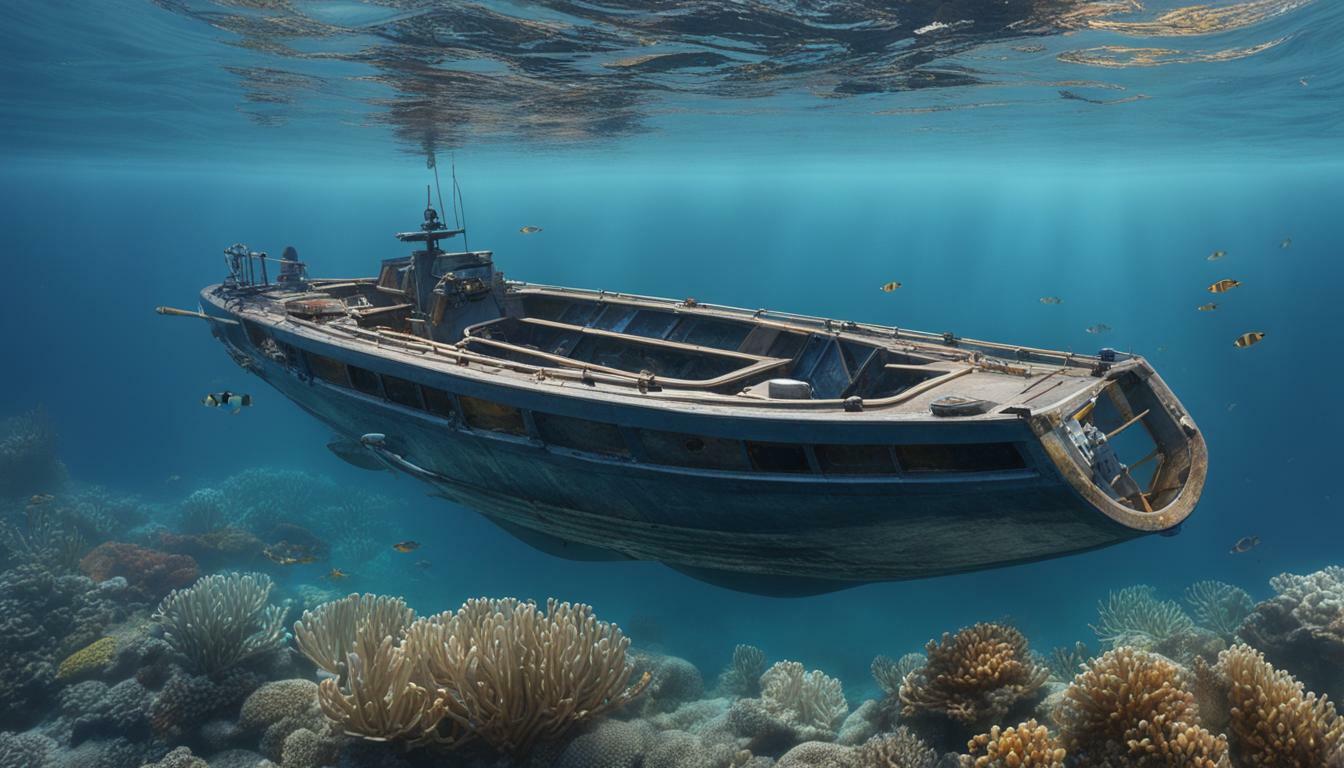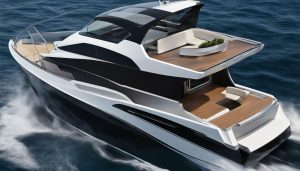Draft is an important concept to understand when it comes to boats. It refers to the vertical distance between the waterline and the lowest point of the boat’s hull. In other words, it is the minimum amount of water needed for a boat to float without touching the bottom. Boats with different propulsion systems may have different calculations for their draft.
Key Takeaways:
- Draft is the vertical distance between the waterline and the lowest point of the boat’s hull.
- Boats with different propulsion systems have different draft calculations.
- Understanding draft is crucial for safe navigation, selecting appropriate mooring options, and optimizing performance.
Calculating Draft for Different Propulsion Systems
For boats with inboard or inboard pod drives, the draft is calculated to the lowest point of the gear below the boat, which could be the propeller or the rudder. On the other hand, boats with outboard or sterndrive engines have the option to raise or lower the drive, which affects the calculation of draft.
When the drive is raised, the boat will have a shallower draft because the lowest point of the boat is the keel. In contrast, when the drive is lowered, the draft will be deeper because the lowest point of the boat is the skeg in front of the propeller.
Jet drive propulsion systems have their entire drive system located within the boat, so the draft is measured to the keel.
The draft calculation should also take into account the boat’s buoyancy. The amount of buoyancy varies depending on the type of hull. Planing hulls, where the boat rises up on the water due to the forward momentum, have less buoyancy than displacement hulls, where the boat moves through the water by pushing it aside. Additionally, vessels with heavier equipment and larger passenger loads will have deeper drafts.
It should be noted that the published draft specification is usually approximate. It is typically measured with the boat in a dry condition, without fuel or water tanks being full. The weight of passengers and gear is also not taken into account. The design of the boat’s hull and the location of passengers can also affect the draft.
How to Measure Boat Draft
If knowing the exact draft is critical, it is recommended to load the boat with typical weight and measure the draft. Manufacturers provide draft measurements for their models, but these can vary depending on the specific configuration, equipment, or load of the boat.
Measuring the draft requires a tape measure and a measuring stick. The measuring stick, also known as a draft rod, is a metal or wooden rod with measurement marks. Place the measuring stick at the bow of the boat where the water meets the hull and measure the distance between the waterline and the lowest point of the boat’s hull. Repeat this process at the stern to get an average draft for the boat.
Understanding the draft of a boat is essential for safe navigation and optimal performance. Boaters need to know the draft of their vessel to avoid running aground in shallow waters, select suitable mooring options, and optimize the boat’s handling and fuel efficiency.
Managing Draft for Shallow Waters
The draft of a boat becomes particularly important when operating in shallow waters. Shallow waters can be found at the entrance to a harbor or dock when the tide is out, or in channels from a home dock to open water. Anglers who fish in shallows or flats also prefer boats that draw as little water as possible.
Boats with outboard or sterndrive engines can be operated with the drive raised to navigate through shallows. However, it is important to note that running a long distance with the drive raised can stress the drivetrain and should be avoided. It’s best to follow these tips for boating in shallow water:
- Be familiar with the depth of the water you are navigating.
- Use a depth finder or chart to identify shallower areas.
- Go slowly and maintain a steady course to minimize the risk of running aground.
- Be aware of the tide and its effect on water depth.
When it comes to calculating the draft of a boat, it is important to keep in mind that the published draft specification is usually approximate. It is typically measured with the boat in a dry condition, without fuel or water tanks being full. The weight of passengers and gear is also not taken into account. The design of the boat’s hull and the location of passengers can also affect the draft.
If knowing the exact draft is critical, it is recommended to load the boat with typical weight and measure the draft. Manufacturers provide draft measurements for their models, but these can vary depending on the specific configuration, equipment, or load of the boat.
Understanding the draft of a boat is essential for safe navigation and optimal performance. It helps boaters avoid running aground in shallow waters, select suitable mooring options, and optimize the boat’s handling and fuel efficiency. By being familiar with the boat’s draft, boaters can navigate confidently and make informed decisions while on the water.
Operating Outboard and Sterndrive Engines in Shallow Water
Boats with outboard or sterndrive engines can be operated with the drive raised to navigate through shallows. However, it’s important to note that running a long distance with the drive raised can stress the drivetrain and should be avoided. Here are some helpful tips for boating in shallow water:
- Be familiar with the depth of the water you are navigating.
- Use a depth finder or chart to identify shallower areas.
- Go slowly and maintain a steady course to minimize the risk of running aground.
- Be aware of the tide and its effect on water depth.
Calculating the draft of a boat is also an important consideration. It’s important to keep in mind that the published draft specification is usually approximate. Typically, it’s measured with the boat in a dry condition, without fuel or water tanks being full. The weight of passengers and gear is also not taken into account, and the design of the boat’s hull and the location of passengers can also affect the draft.
If knowing the exact draft is critical, it’s recommended to load the boat with typical weight and measure the draft. Manufacturers provide draft measurements for their models, but these can vary depending on the specific configuration, equipment, or load of the boat.
Understanding the draft of a boat is essential for safe navigation and optimal performance. It helps boaters avoid running aground in shallow waters, select suitable mooring options, and optimize the boat’s handling and fuel efficiency. By being familiar with the boat’s draft, boaters can navigate confidently and make informed decisions while on the water.
Factors Affecting Draft Calculation and Variations
When it comes to calculating the draft of a boat, it is important to keep in mind that the published draft specification is usually approximate. It is typically measured with the boat in a dry condition, without fuel or water tanks being full. The weight of passengers and gear is also not taken into account. The design of the boat’s hull and the location of passengers can also affect the draft.
Boats with planing hulls, for example, tend to ride on top of the water, resulting in a shallower draft. Conversely, boats with displacement hulls that push through the water, will have a deeper draft. Similarly, boats with heavy loads, such as fishing gear and supplies, will have a deeper draft compared to those with light loads.
Passenger weight distribution can also affect the draft. If passengers are located in the forward part of the boat, the draft will be shallower than if they were located in the rear. Furthermore, boats with trim tabs or adjustable ballast systems can adjust the draft while underway to optimize performance and fuel efficiency.
The Importance of Boat Draft
Understanding boat draft is crucial for several reasons. Firstly, it helps boaters avoid running aground, which can potentially damage the boat or cause injury to passengers. Secondly, it helps boaters select appropriate mooring options based on the water depth. Finally, optimized draft can enhance a boat’s handling, fuel efficiency, and overall performance.
Factors affecting draft calculation and variations can be taken into account to optimize performance and fuel efficiency. Boaters can adjust the draft by redistributing weight, adjusting trim tabs, or using adjustable ballast systems. By maintaining optimal draft, boaters can navigate comfortably and safely while maximizing the boat’s performance.
Measuring Draft for Accurate Specifications
If knowing the exact draft is critical, it is recommended to load the boat with typical weight and measure the draft. Manufacturers provide draft measurements for their models, but these can vary depending on the specific configuration, equipment, or load of the boat.
To measure the draft, follow these steps:
- Load the boat with typical weight, including fuel and water tanks.
- Locate the waterline on the boat’s hull. This can be done visually by observing the waterline on the hull while the boat is in the water, or by using a marker to create a waterline on the hull while the boat is on land.
- Measure the vertical distance from the waterline to the lowest point of the boat’s hull. This is the draft of the boat.
It is important to keep in mind that the draft can change based on the boat’s load and weight distribution. Therefore, it is recommended to measure the draft multiple times under different load and weight conditions to get a comprehensive understanding of the boat’s draft specifications.
The Importance of Understanding Draft for Safe Navigation
Understanding the draft of a boat is essential for safe navigation and optimal performance. It helps boaters avoid running aground in shallow waters, select suitable mooring options, and optimize the boat’s handling and fuel efficiency. By being familiar with the boat’s draft, boaters can navigate confidently and make informed decisions while on the water.
Boats with shallow draft can navigate in areas where deeper-draft boats cannot, making them more versatile in terms of where they can go. However, it’s important to keep in mind that a boat’s draft can also affect its stability and safety in certain conditions.
Boats that draw too little water may end up being unstable in choppy or rough conditions, while boats with too much draft may be at risk of running aground or encountering underwater obstacles. It’s important to find the right balance for your boat’s draft, depending on the conditions and your intended use.
When navigating in shallow waters, it’s important to be aware of the depth of the water you are in and to use a depth finder or chart to identify shallower areas. Going slowly and maintaining a steady course can help minimize the risk of running aground, and being aware of the tide and its effect on water depth can help you avoid unexpected surprises.
If knowing the exact draft of your boat is critical, it’s recommended to load the boat with typical weight and measure the draft. Manufacturers provide draft measurements for their models, but these can vary depending on the specific configuration, equipment, or load of the boat.
Overall, understanding boat draft is crucial for safe navigation and optimal performance. By being familiar with your boat’s draft and how it affects your boating experience, you can make informed decisions and enjoy your time on the water with confidence.
Optimizing Draft for Performance and Efficiency
When it comes to optimizing draft, it’s important to keep in mind the intended use of the boat. For example, if the boat is primarily used for fishing in shallow waters or navigating through a channel, minimizing draft should be a priority. On the other hand, if the boat is used for cruising or traveling long distances, a deeper draft may be preferred for stability and enhanced performance.
Calculating the optimal draft for a boat typically involves balancing buoyancy and performance. A boat with greater buoyancy will have a larger surface area and be more stable, but it may also have a slower speed and higher fuel consumption. On the other hand, a boat with a lower draft and less buoyancy may be faster and more fuel-efficient, but may not handle as well in rough water or heavy loads.
One way to optimize boat draft is to reduce weight. This can be achieved by removing unnecessary equipment, supplies, or gear. It’s also important to distribute weight evenly throughout the boat to maintain balance and minimize any effect on the boat’s draft.
Another strategy is to adjust trim. The trim refers to the boat’s angle in relation to the water. By adjusting the trim, boaters can raise or lower the bow of the boat, which can affect the boat’s draft. For example, if the bow is raised, the draft will be reduced, allowing the boat to navigate in shallower waters. However, it’s important to note that adjusting the trim can also affect the boat’s handling and performance, so it should be done carefully and gradually.
Overall, optimizing draft can enhance a boat’s handling, fuel efficiency, and overall performance. By carefully considering the intended use of the boat, reducing weight, and adjusting trim, boaters can make informed decisions to achieve the desired level of draft for their boating needs.
Conclusion
In conclusion, draft is an important consideration when it comes to boats. It refers to the vertical distance between the waterline and the lowest point of the boat’s hull. Different types of propulsion systems and hull designs can affect the calculation of draft. Understanding the boat’s draft is crucial for safe navigation, selecting appropriate mooring options, and optimizing performance.
Boats with outboard or sterndrive engines can be operated with the drive raised to navigate through shallows, but it is important to do so carefully to avoid damaging the boat’s drivetrain. When calculating the draft of a boat, keep in mind that the published specification is usually approximate, and passenger weight and gear can affect the measurement. To get an accurate measurement, it is best to load the boat with typical weight and measure the draft.
Understanding the draft of a boat is essential for safe navigation and optimal performance. It helps boaters avoid running aground in shallow waters, select suitable mooring options, and optimize the boat’s handling and fuel efficiency. By being familiar with the boat’s draft, boaters can navigate confidently and make informed decisions while on the water.
FAQ
Q: What is draft on a boat?
A: Draft on a boat refers to the vertical distance between the waterline and the lowest point of the boat’s hull. It is the minimum amount of water needed for the boat to float without touching the bottom.
Q: How do you calculate draft for different propulsion systems?
A: The calculation of draft varies based on the type of propulsion system. For boats with inboard or inboard pod drives, the draft is calculated to the lowest point of the gear below the boat. Boats with outboard or sterndrive engines have the option to raise or lower the drive, so two draft specifications are published: one with the drive up and another with the drive down. Jet drive propulsion systems have their entire drive system located within the boat, so the draft is measured to the keel.
Q: How can you manage draft for shallow waters?
A: Managing draft in shallow waters is important to avoid running aground. Tips for managing draft in shallow waters include being familiar with the water depth, using a depth finder or chart to identify shallower areas, going slowly and maintaining a steady course, and being aware of the tide and its effect on water depth.
Q: How do you operate outboard and sterndrive engines in shallow water?
A: Boats with outboard or sterndrive engines can be operated with the drive raised to navigate through shallow waters. However, it is important to note that running a long distance with the drive raised can stress the drivetrain and should be avoided.
Q: What factors affect draft calculation and variations?
A: Draft calculation can be affected by factors such as hull design, passenger weight, and equipment load. These factors can cause variations in the draft of a boat.
Q: How do you measure draft for accurate specifications?
A: To measure the draft accurately, it is recommended to load the boat with typical weight and measure the draft. Manufacturers provide draft measurements for their models, but these can vary depending on the specific configuration, equipment, or load of the boat.
Q: Why is understanding draft important for safe navigation?
A: Understanding draft is important for safe navigation as it helps boaters avoid running aground in shallow waters, select suitable mooring options, and optimize the boat’s handling and fuel efficiency.
Q: How can optimizing draft enhance boat performance and efficiency?
A: Optimizing draft can enhance a boat’s handling, fuel efficiency, and overall performance. By understanding and managing the boat’s draft, boaters can navigate confidently and make informed decisions while on the water.


